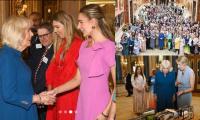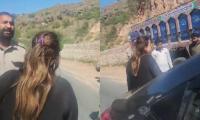This pandemic has drawn a clearer picture of our skies on a canvass of empty roads, which is presented to global audiences frequently. Not so frequently, however, is seen the picture of our class divides that too is showing as really as a rusted car on a highway otherwise flowing with trendy vehicles.
It seems that there are ‘three Islamabads’ rising and falling in one city idly. One Islamabad lives in its settled sectors of E, F and G series. The other languishes in its rural areas. And the third Islamabad is walled up and barbwired in housing societies that are pushing at the limits on the edges of nearby districts.
These societies have become castles unto themselves and every one of these has now kind of slithered back into their shells. The prime minister has not announced a lockdown in the federal capital. The district administration locked down and then opened only a couple of areas in the city upon discovery of corona positive patients there.
But going over and above the government guidelines, almost all societies have closed their gates. Situation is worse for residents of the area who live in surroundings of these societies and have to cross them to reach their destinations.
In normal days, it is usual to see lines of motorcyclists, and labourers at the gates of these societies waiting for their security clearance, resembling the scenes we witness at European borders, where non-Europeans are lined up, on global media.
This breach of humanity in the name of security was already accepted and promoted. From Faizabad to Mandra, almost all societies are illegal but everyone blames the Capital Development Authority (CDA) not to build Islamabad Expressway for them from Koral to Rawat. No one has ever raised the question of civic responsibility of these societies who have earned billions of rupees and are not willing to spend a bit from this amount for the benefit of their residents.
CDA Chairman Amer Ahmed Ali (AAA) told me that societies from Koral to Rawat will “pitch in” in construction of the Expressway and bridges.
“Already, these societies have contributed in construction of two interchanges. More will follow. If they want access to the Expressway, they will have to show civic responsibility,” he said.
On the exclusionary nature of the design of Naval Anchorage Interchange, he said, “The design of Naval Anchorage Interchange will be revisited. No project can be or should be allowed to follow an exclusive and exclusionary approach.”
He explained, “Any structure (underpass or flyover) will be as per CDA design to cater for the entire population (and not only residents of a certain locality).”
Asked about responsibility of the CDA vis-à-vis housing needs of the people of Islamabad, he said “unfortunately, the CDA has missed out” its goals for two decades. This failure gave way to private projects, he said.
Giving hope, he said the civic body has now revived stalled projects. “It (housing projects) is a challenge but with the grace of Almighty we will do it. This, rather, is our main job,” he said.
Explaining how it will be done, he said, “Now that sanitation, environment and street lights etc. have become a responsibility of the Municipal Corporation Islamabad (MCI), development of the city is our main task. Development of Sector I-15 will start this month. Park Enclave 1 will be completed in a couple of months. A mosque with Moroccan Architecture will be built there. Work on Park Enclave 2 has also started. Work on E-12 is in full swing. So residents of Islamabad have some good news at last.”
He said legal private housing projects are encouraged as a policy and illegal elements are discouraged.
AAA is also the chief commissioner of the federal capital and this centrality of command has streamlined management of the city. He said that the city administration is vigilant to crimes against individuals and no effort is spared to keep order in the city.
These steps are needed for the federal capital to give look of a city instead of that of an assembly of stables for different breeds of studs.
Federal Minister for Science and Technology Khalid Maqbool Siddiqui being briefed about departments at NUTECH...
The Pakistan Medical and Dental Council building seen in this image. — APP/FileIslamabad:Pakistan Medical and...
Participants gestures at ‘Dialogue on Assisting Afghan Media Practitioners in Pakistan’ on April 29, 2024. —...
PM's Coordinator on Climate Change and Environmental Coordination, Romina Khurshid Alam meets with the Ambassador of...
This image shows the logo of the Unicef. — APP/FileIslamabad:Unicef Pakistan launched its National Gender Strategy ...
This representational image shows the hands of an incarcerated person. — AFP/FileRawalpindi: A fake food inspector...







